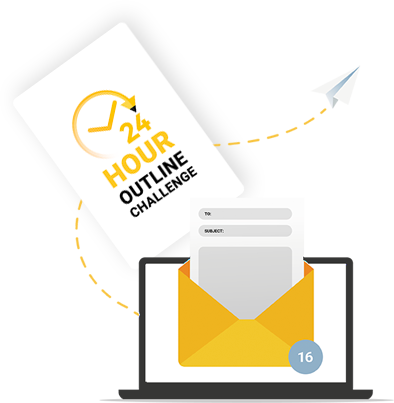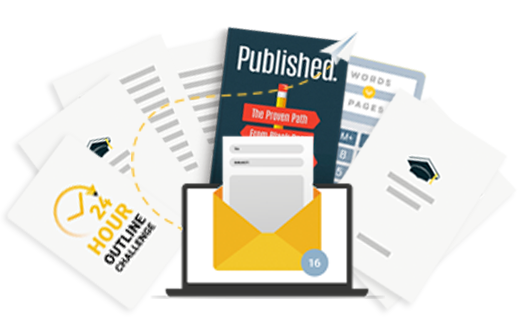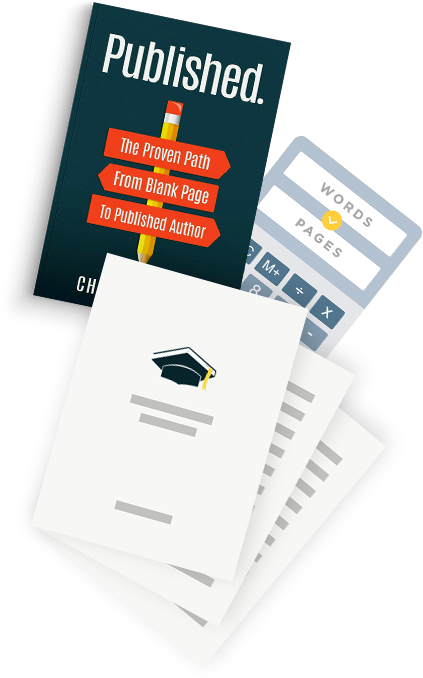Are you looking for print on demand books to boost your sales as a self-published author?
The days of having to bulk order large quantities of your book only to have them rot away in your basement are thankfully over!
These days, a range of different services exist allowing you to only order the quantity of books you need at the time you need them.
Read on to discover everything you need to know about print on demand books, including what they are, where you can get them, and relevant advice to be aware of.
This exploration of print on demand books explains:
- What are print on demand books?
- Print on demand companies for books
- How much do print on demand books cost?
- How to choose the right POD option for your book
What are print on demand books?
Before we get into print on demand, let’s talk about traditional printing.
Traditional printing
When books are published, the publisher or the author usually has to order a palette of books at a time. A palette will be a large number of books, as they’re mass-produced, so authors have to sell a lot of books to justify ordering another amount. You may have heard of books ‘going back to print,’ and this is basically what they’re referring to. A book has sold enough copies that the publisher is ordering another set of books from their manufacturer.
This is why presales are so important for traditional and indie authors alike. Having an idea of how many people are interested in buying a copy gives everyone a better idea of how many books they’re going to need to order.
The downside to traditional printing like this is that if you’re a self-published author, you’re ordering these copies yourself, often at a fee. You’re going to have to store them, and the cost can be pretty steep up-front. The cost per book is lower if you traditionally print, but the up-front cost is still high.
The pro to traditional printing is that you generally get a lot of involvement in the printing process—you might get more say in what sort of paper you use, for example. And like I said before, while the initial cost is high, the cost per book printed tends to be lower. Additionally, it’s usually much easier to get brick and mortar stores to sell traditionally printed books.
Print on demand
Print on demand differs from traditional printing because instead of printing sets of books yourself, you’re paying a company to print books to order. When someone makes a purchase, the book is printed and shipped to that customer.
The cons for print on demand? The author is usually afforded less opportunity for quality control (although many print on demand companies are perfectly reliable, and even traditionally published books can print wacky copies sometimes), and while there isn’t an up-front cost, you’re probably going to have to pay the print on demand company a set-up and yearly fee.
It’s also important to know that print on demand books can be difficult to get into brick and mortar stores. There are ways to work around this, and it doesn’t mean your book can’t be sold in a brick and mortar store—it just means it’ll be a little trickier, and that’ll be something to keep in mind if you want to sell your books in a physical bookstore.
While all of this may make it sound like print on demand is a bad option for self-published writers, that’s not necessarily true! Print on demand can be a hugely helpful and accessible option for writers who don’t have the resources, time, or space to print, store, and ship their books. It takes a huge weight off the author to be able to outsource that to a print on demand company.
A note, though: print on demand doesn’t necessarily guarantee that the company will handle distribution for you. Many of them do, and many of them will at least let you list the book for sale on their website for free. But you’ll want to do some research into the company you like to get a sense of what sorts of distribution they do, if they do any at all. You may need to buy an ISBN in order for them to distribute—some companies will help you with this, though, and it’s often not super expensive to do.
Print on demand companies for books
Here are just a few print on demand companies for you to check out:
1 – Ingramspark
Ingramspark is one of the most popular print on demand companies out there. They’ll connect you to over 40,000 libraries, retailers, and e-commerce companies, which means it’s a huge help when it comes to distribution. The cost of uploading a book to print on Ingramspark is $49, which includes the ebook version. Ingramspark also gives you some options as far as formatting goes, which offers some customizability.
2 – Draft2Digital
Draft2Digital offers some customizing options, like glossy or matte finish or cream or white paper, and it offers some options for distribution, as well. Brick and mortar stores are able to order copies of your book through Draft2Digital, which will generally make it easier to sell in those stores than if you brought your own copies to sell.
3 – Acutrack
Acutrack allows authors to work with their prepress team to finalize your product before it goes to print. They offer a variety of different options for your book and they let you order anywhere from 1-1000 copies at a time, making the process super customizable. They also integrate the book into whatever storefront you use, allowing for easier distribution.
4 – Amazon KDP
KDP is perhaps the most popular and widely-used print on demand publisher, and it’s easy to see why. It’s extremely user-friendly for self-published authors. Not only will Amazon give you a free ISBN with your paperback sale, but this will also allow you to use their Expanded Distribution Network, which allows other companies like stores and schools to order copies of your book. They’ll have your book ready between twenty-four and forty-eight hours, and if you haven’t created your own manuscript, they have templates for authors to use.
5 – Lulu
Unlike many other companies, Lulu lets you print hardcover books as well as paperback. They also offer a huge variety of book formats, like yearbooks, comics, or novels. This versatility means authors can make their books much more personalized, and it gives the author more say in how the book turns out. You’ll be able to sell on Amazon, but it takes a little longer for Lulu to get your book ready than Amazon does.
6 – Bookbaby
Bookbaby is also a great option for self-published authors, but it might be better for self-published authors with an established platform and some cash to invest in their production. The cost for using Bookbaby is a bit steeper than other platforms, and they allow print-to-order after an initial order of twenty-five books. This means you have to order twenty-five books first before print-to-order comes into play.
7 – The Book Patch
The Book Patch advertises no setup or listing fees and instead charges based on the number of books you order. The more books you buy, the cheaper the book. You also could potentially keep all of your royalties using The Book Patch, making this a compelling option if the steep fees on Lulu or KDP are a deterrent for you.
8 – Blurb
Blurb allows you to straightforwardly order books as-needed to print. There are fees if you want to sell through sites like Amazon, but you can sell your book through Blurb’s website for free. They also allow the author some control over the profit margins on each sale.
9 – Trafford Publishing
Trafford Publishing is another option for self-published authors with a little more cash to invest. They offer printing if you buy one of their packages. They’re an established company with quality printing, so in exchange for the up-front cost, you’re getting a very polished product.
10 – Diggy POD
Diggy POD allows you to print books in batches of twenty-four, and they offer a pricing calculator on their website with more detailed information. They also offer free shipping on orders above one hundred.
11 – Espresso Book Machine
Not only does this company allow you to collaborate with editors and designers, but it allows stores and libraries to print books in-house using special printers. This basically takes out the middle man, or a retailer, and brings the book directly to the library or school ordering the book.
12 – 48hr Books
Like the name implies, 48hr Books gets your book ready to go between twenty-four and forty-eight hours. They have the option to print hardcover, and they have templates for authors to use if they’re unable to get their own formatting done. However, this company does require authors to order a minimum of ten books, which means it isn’t technically print-on-demand in the literal sense.
How much do print on demand books cost?
So, how much is all of this gonna cost?
It depends. The cost can vary widely depending on which company you use. Broadly speaking, though, there are going to be two places to look when it comes to the cost of print-on-demand: up-front fees and royalties.
Let’s use KDP as an example. KDP doesn’t charge anything to set a book up on their storefront, but they do take a chunk of the profits. On their website, they say that for books sold through Amazon’s storefront, the author gets 60% in royalties (which means the author gets 60% of the money made on the sale). If the book is sold through Amazon’s Expanded Distribution channels, the royalties go down to 40%.
Ingramspark takes a little less of the royalties, but they charge a setup fee of $49 to upload a title to print.
Many of these companies will offer pricing calculators, which can give you a better idea of what you’re going to pay them in setup fees and in royalties. It’s also worth knowing that using something like Ingramspark might appeal more to brick-and-mortar stores who don’t want to buy from Amazon, since they’re competitors.
This isn’t to deter you from using KDP or Ingramspark—both are reputable companies which can allow their authors to make a living with their writing—but it is to say that before you settle on an option, look into the company and do your research. Decide what’s important to you. Do you want the option to distribute your book to basically anyone, or are you fine with having it just on that company’s website?
Some companies also offer print on demand in conjunction with packages that you have to buy first. These tend to be the pricier options. Bookbaby, for example, charges $399 for their package which allows distribution on sites like Amazon.
How to choose the right POD option for your book
As with every step in the self-publishing process, budgeting is going to be key. First, you’ll need to decide whether print on demand is the best option for you. If it is, then you’ll need to compare different features across different companies. And you’ll need to have a budget in mind.
If you’re a brand-new self-published author not looking to break the bank, signing up for an expensive package might not be the most viable solution. While Ingramspark or KDP might take some of the royalties, they won’t break the bank, which might make it a safer overall choice. It all depends on what you’re able to spend on the printing of your book and what’s best for you.
Want to sell more books? Check out our list of book promotion sites!



